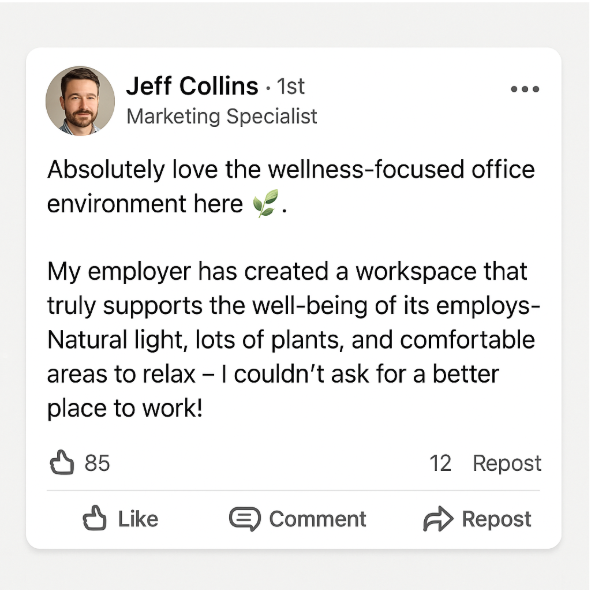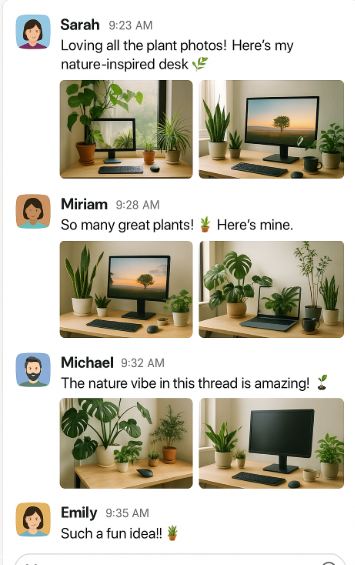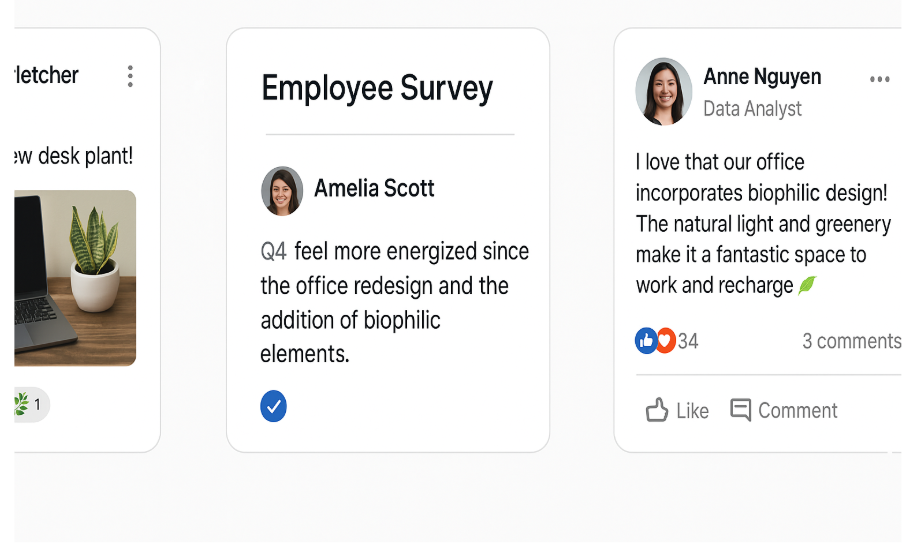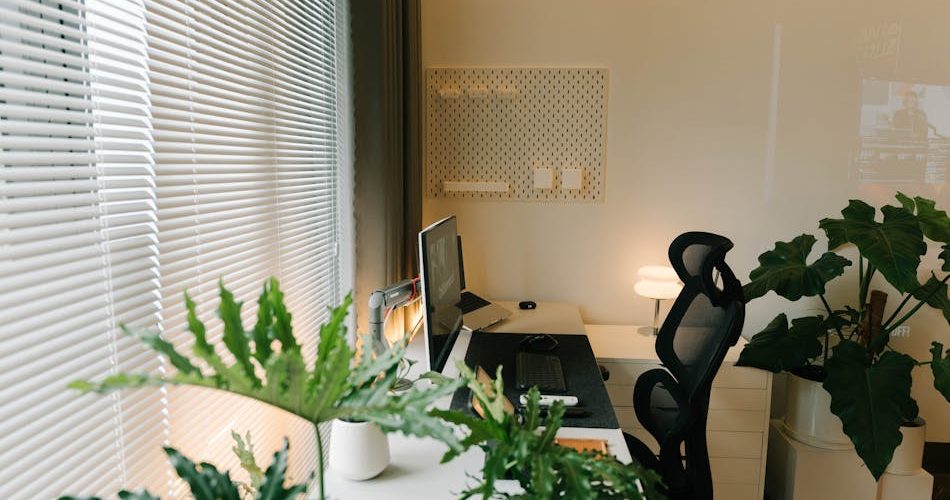In today’s fast-paced and often stressful work environments, employee well-being has become more than a nice-to-have—it’s a business priority. As organizations across the globe rethink their office spaces, many forward-thinking leaders are turning to biophilic design as a practical and inspiring solution. This nature-driven approach to workplace design is transforming how employees feel, focus, and thrive at work.
A well-crafted nature-inspired workspace isn’t about adding a few potted plants—it’s about creating an environment that naturally supports employee wellness, reduces burnout, and encourages people to actually want to come into the office. Whether employees are fully in-office or splitting time in a hybrid model, the spaces they occupy play a huge role in shaping their experience, productivity, and mental health.
In this blog, we’ll explore how integrating elements of biophilic design can foster a happier, healthier, and more engaged workforce. You’ll discover actionable ideas, real-world examples, and why workplace design should be part of every company’s employee wellness strategy.
What Is Biophilic Design? A Quick Primer
Before diving into the benefits, let’s clarify what biophilic design actually means. It’s not just about adding a few potted plants in the corner—it’s a strategic approach to workplace design that reconnects employees with nature.
Biophilic design incorporates three core elements:
- Direct Connection to Nature – Think sunlight, greenery, water features, fresh air, and natural materials.
- Indirect Connection to Nature – Use of patterns, textures, and colors inspired by natural environments.
- Space and Place Conditions – Creating spaces that feel open, calming, and reflective of natural ecosystems (like cozy corners, open lounges, or garden-style break areas).
By thoughtfully weaving these elements into office spaces, companies can create environments that reduce stress, encourage focus, and improve overall employee well-being.

The Business Benefits of Biophilic Design in the Workplace
Investing in biophilic design isn’t merely about aesthetics—it brings measurable psychological and organizational benefits. Here’s how it can positively impact employees and the company:
1. Reduced Stress and Improved Mental Health
Natural elements like plants, daylight, and open spaces have been shown to significantly reduce stress levels. According to a study on mental well-being, employees exposed to biophilic environments report lower anxiety and improved mood.
2. Increased Productivity and Focus
Biophilic workplaces can improve cognitive function by up to 15%, as indicated in this research on biophilic design and productivity. Natural light, views of nature, and calming materials help employees stay more focused and energized.
3. Enhanced Creativity and Problem-Solving
A connection to nature has a strong link to creative thinking. Offices that weave in natural patterns, textures, and views have been found to boost creative output, as highlighted in this study on biophilic creativity.
4. Reduced Absenteeism and Turnover
A healthier, more engaging workplace results in lower absenteeism and better retention rates. Research on workplace wellness shows that biophilic environments contribute to higher job satisfaction and fewer sick days.
5. Stronger Employer Brand
A thoughtfully designed, wellness-focused workspace signals to current and future employees that the company cares about their well-being. It becomes part of the company’s employer brand strategy, as explored in this article on workplace well-being.
Real-World Examples of Biophilic Office Design
Several leading organizations have successfully incorporated biophilic design into their workplaces:
-
Amazon’s Spheres – Seattle, USA
At Amazon’s headquarters, The Spheres are a series of glass domes housing over 40,000 plants from around the world. These unique spaces allow employees to work and collaborate surrounded by nature, creating an urban rainforest experience in the heart of the city. -
The Terry Thomas Building – Seattle, USA
The Terry Thomas Building is a textbook example of biophilic and sustainable design. With its central open-air courtyard, operable windows, and daylight-optimized architecture, the building fosters a healthier, naturally lit workspace that reduces dependence on artificial systems. -
Tower at PNC Plaza – Pittsburgh, USA
The Tower at PNC Plaza integrates nature through its innovative double-skin façade and solar chimney, which enable natural ventilation and fresh air circulation. It also features an indoor park on the 28th floor, providing employees a space to unwind amidst greenery. -
Mountbatten House (The Hanging Gardens of Basingstoke) – UK
Known for its rooftop gardens, Mountbatten House has undergone a £32 million restoration to revive its extensive plant-covered terraces. Originally built in the 1970s, the building blends nature into the workspace, promoting employee well-being through lush, elevated gardens.
How to Bring Biophilic Design to Life: Budget-Friendly Ideas for Any Workplace
You don’t need to renovate your entire office or invest millions in architecture to infuse biophilic design. Even small, intentional changes can dramatically improve employee well-being, focus, and creativity. Here are practical, low-cost ways to introduce nature into your workplace—whether you’re in a skyscraper or a remote team setup:
1. Desk-Friendly Greenery
Provide employees with small, low-maintenance plants like succulents, snake plants, or pothos. You can even launch a monthly “Plant Swap” event where employees exchange cuttings, nurturing community and greenery together.
2. Natural Light Optimization
Rearrange workstations to maximize exposure to natural light. If windows are limited, use daylight LED bulbs and reflective surfaces to mimic daylight and reduce fatigue.
3. Nature-Inspired Breakout Zones
Create cozy nooks with natural materials—think bamboo chairs, jute rugs, wooden shelves, and soft lighting. Add forest-themed murals or artwork to make the space immersive.
4. Living Walls & Vertical Gardens
Even in small spaces, a modular living wall can bring vibrancy. If budget is tight, opt for wall-mounted planter pockets or trailing vines.
5. Digital Biophilia
Use large screens in common areas to stream nature videos—like waterfalls, forests, or ocean waves. Pair them with nature soundscapes to create a calming atmosphere.
6. Aromatherapy with Natural Scents
Introduce diffusers with essential oils like lavender, eucalyptus, or citrus. Scents can subconsciously improve mood, focus, and relaxation.
7. Outdoor Working Spaces
If your office has a terrace, balcony, or courtyard, convert part of it into a casual workspace with plants, shade structures, and comfortable seating.
8. Nature-Inspired Remote Work Practices
For hybrid or remote teams, encourage employees to work near windows, step outside between meetings, or even share photos of their favorite outdoor work spots in Slack channels.
9. Natural Materials in Office Decor
Swap plastic and synthetic materials for wood, cork, stone, or cotton in office furniture and accessories. Even simple corkboards or wooden pen holders bring subtle nature elements inside.
10. Biophilic Wellness Challenges
Gamify wellness by organizing monthly challenges—like “Who grew the best desk plant?” or “Daily 10-minute walk in nature.” Recognize winners in team meetings or internal newsletters.
Employee Voices: What Real People Say About Biophilic Workspaces
While research and design principles make a strong case, nothing resonates more than hearing from employees themselves. When workplaces embrace biophilic design, it’s not just the space that changes—it’s how people feel, engage, and show up every day.
Here’s what employees across industries have shared about working in nature-inspired environments:
“It’s subtle, but the difference is huge. Since our office added plants and natural textures, I feel less drained by midday. It’s like a little mental recharge every time I glance at the greenery.”
— Jasmine K., Content Strategist, Toronto
“My productivity improved without me even realizing it. I used to stare at gray walls all day. Now, the natural light and plants make the office feel more human and less corporate.”
— Liam D., Software Engineer, Sydney
“We started a ‘Plant Parenting Challenge’ at work. It sounds silly, but it brought the team together. Everyone started talking more, sharing plant tips—it shifted the mood completely.”
— Priya R., HR Manager, London
“During the pandemic, our company encouraged us to share photos of our ‘nature-inspired’ remote setups. It sparked real conversations about well-being and work-life balance.”
— Carlos M., Project Lead, Chicago



Cost vs. ROI Breakdown: Is Biophilic Design Worth It?
One of the biggest barriers to adopting biophilic design is the misconception that it’s an expensive, non-essential luxury. But when you compare the upfront investment to the long-term returns in employee well-being, productivity, and retention, the numbers tell a very different story.
What Does It Cost?
Here’s a rough estimate of common biophilic design elements:
| Biophilic Element | Approximate Cost (One-Time) |
| Indoor Plants (per plant) | $50 – $250 |
| Living Green Wall (per sq. ft.) | $100 – $200 |
| Natural Wood & Stone Features | $2,000 – $10,000 (depends on area) |
| Skylights/Natural Light Installations | $1,500 – $4,000 per unit |
| Biophilic Office Redesign (full-scale) | $30,000 – $150,000+ (varies by size) |
What’s the ROI?
🔸 A landmark Human Spaces study found that employees working in offices with natural elements reported a 15% higher well-being score and 6% higher productivity.
🔸 According to a World Green Building Council report, companies that invested in healthier, nature-infused office spaces reported:
- Absenteeism reduced by 10%
- Retention improved by up to 15%
- Productivity increased by 8-11%
🔸 A real-world example is Amazon’s Spheres HQ, which integrates large-scale biophilic design. Their initiative demonstrated that adding nature-led design improved employee satisfaction scores by 18%.
Why It’s a Smart Investment
When you compare these returns against the costs:
- Even a modest $5,000 investment in greenery and natural materials can quickly pay off by reducing one resignation or a few absentee days.
- For large-scale redesigns, companies recover costs through better talent retention, higher productivity, and improved mental health outcomes.
In short: Biophilic design is not an expense. It’s an investment in your people—and your business longevity.
Conclusion: Building a Healthier Workplace, One Leaf at a Time
The modern workforce isn’t motivated by paychecks alone. They crave environments that nurture well-being, creativity, and a sense of belonging. Biophilic design isn’t just an aesthetic choice—it’s a business strategy rooted in science and human psychology.
For HR leaders and workplace experience teams, the message is clear:
Investing in nature is investing in people.
Whether it’s adding a few plants, redesigning collaborative spaces with natural elements, or simply increasing access to daylight, small changes can create a measurable impact on employee satisfaction, retention, and productivity.
And in an era where talent is your most valuable asset, that impact is priceless.



